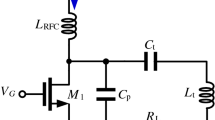Abstract
Magnetic transcutaneous coupling is frequently used for power and data transfer to implanted electronic devices. The paper describes a transmitter/coil driver based on the class E topology. The development of a ‘high-Q approximation’ simplifies the design procedure. A method of data modulation using synchronous frequency shifting is decribed. The class E circuit shows great promise, especially for circuits with unusually low coefficients of coupling. Transmitter coil currents of several amperes, at radio frequencies, with relatively low active device power dissipation, can easily be obtained.
Similar content being viewed by others
References
Donaldson, N. de N. andPerkins, T. A. (1983) Analysis of resonant coupled coils in the design of radio frequency transcutaneous links.Med. & Biol. Eng. & Comput.,21, 612–627.
Galbraith, D. C., Soma, M. andWhite, R. L. (1987) A wideband efficient inductive transdermal power and data link with coupling insensitive gain.IEEE Trans.,BME-34, 265–275.
Gutmann, R. J. (1980) Application of RF circuit design principles to distributed power converters.,IECI-27, 156–164.
Heetderks, W. J. (1988) RF powering of millimeter- and submillimeter-sized neural prosthetic implants.,BME-35, 323–327.
Kazimierczuk, M. K. andPuczko, K. (1987) Exact analysis of class E tuned power amplifier at anyQ and switch duty cycle.,CAS-34, 149–159.
Kazimierczuk, M. K. andBui, X. T. (1989) Class E dc/dc converters with an inductive impedance inverter.,PE-4, 124–135.
Redl, R., Molnar, B. andSokal, N. O. (1986a) Class E resonant regulated dc/dc power converters: analysis of operations, and experimental results at 1·5 MHz.,PE-1, 111–120.
Redl, R., Molnar, B. andSokal, N. O. (1986b) Small-signal dynamic analysis of regulated class E dc/dc converters.,PE-1, 121–128.
Sokal, N. O. andSokal, A. D. (1975) Class E—a new class of high efficiency tuned single-ended switching power amplifiers.IEEE J. Solid-State Circuits,10, 168–176.
Soma, M., Galbraith, D. C. andWhite, R. L. (1987) Radiofrequency coils in implantable devices: misalignment analysis and design procedure.IEEE Trans.,BME-34, 276–282.
Zulinski, R. E. andSteadman, J. W. (1987) Class E power amplifiers and frequency multipliers with finite dc-feed inductance.,CAS-34, 1074–1084.
Author information
Authors and Affiliations
Rights and permissions
About this article
Cite this article
Troyk, P.R., Schwan, M.A. Class E driver for transcutaneous power and data link for implanted electronic devices. Med. Biol. Eng. Comput. 30, 69–75 (1992). https://doi.org/10.1007/BF02446196
Received:
Accepted:
Issue Date:
DOI: https://doi.org/10.1007/BF02446196




